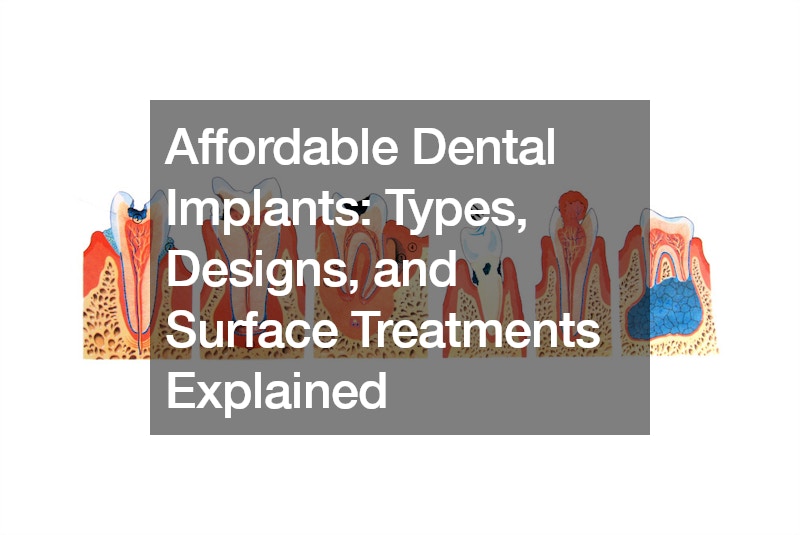

Missing teeth can significantly impact your oral health, confidence, and even ability to eat comfortably. Dental implants offer a permanent solution to missing teeth, restoring both function and aesthetics. However, the initial cost of dental implants can be a concern for many individuals in the United States.
This comprehensive guide explores the world of affordable dental implants, delving into different implant types, designs, and surface treatments that can influence cost. By understanding these factors, you can make informed decisions alongside your dentist to achieve a healthy smile within your budget.
Why Choose Dental Implants?
Dental implants are the gold standard for replacing missing teeth. These small, screw-like posts are surgically embedded into the jawbone, acting as artificial tooth roots. Over time, the jawbone fuses with the implant, creating a strong and stable foundation for a replacement tooth (crown, bridge, or denture). Here’s why implants are a popular choice:
Durability and Longevity: Implants can last a lifetime with proper care, making them a cost-effective investment in the long run. Improved Oral Health: Unlike traditional bridges, implants don’t require altering adjacent healthy teeth. This preserves your natural tooth structure. Enhanced Function: Implants feel and function similarly to natural teeth, allowing you to eat, speak, and smile with confidence. Natural Appearance: Dental implants support a custom-made crown that seamlessly integrates with your existing teeth for a natural aesthetic. Understanding Implant Costs
While dental implants offer numerous benefits, the initial cost can be a barrier for some. The final price tag depends on several factors:
Number of Implants Needed: The number of implants required varies depending on the number of teeth missing and the type of restoration planned (single crown, bridge, or full denture). Implant Material: Titanium is the most common and biocompatible implant material. However, some advanced materials may be used in specific cases, impacting the cost. Surgical Complexity: The complexity of the surgical procedure can influence the cost. Factors like bone grafting or sinus lifts might be involved in some cases. Location: Dental implant costs can vary depending on your geographic location and the experience level of the dentist or oral surgeon performing the procedure. Affordable Dental Implant Options
Fortunately, several strategies can help make dental implants more affordable:
Treatment Planning: Consulting a qualified dentist experienced in implant dentistry is crucial. They will develop a personalized treatment plan based on your needs and budget. This may involve exploring alternative implant designs or surface treatments that offer cost savings without compromising quality. Cost Transparency: Discuss fees upfront with your dentist. Understand the breakdown of costs for the implants, surgery, and restoration (crown, bridge, or denture). Payment Plans: Many dental practices offer flexible payment plans to help manage the cost of dental implants. Dental Insurance: While most traditional dental insurance doesn’t cover the entire cost of implants, some plans may offer partial coverage for certain procedures, such as the surgical placement or the crown itself. Explore your existing dental insurance plan for details on potential coverage. Alternative Financing Options: Dental financing companies and credit unions offer specialized loan options for dental procedures, including implants. These can help spread out the cost into manageable monthly payments. Types of Dental Implants
There are several types of dental implants available, each with its advantages and potential cost implications:
Endosteal Implants: These are the most common type of implant, surgically placed directly into the jawbone. They come in various lengths and diameters to suit different jawbone conditions and treatment needs. Subperiosteal Implants: These are placed on top of the jawbone and are typically used when jawbone quality or quantity is insufficient for traditional endosteal implants. They may be less common and potentially more expensive due to the specialized technique. Zygomatic Implants: These longer implants are used in the upper jaw when there’s insufficient bone in the sinus area. Due to the surgical technique involved, they can be a more complex and potentially costlier option. Implant Designs
The design of the implant can also influence its affordability:
Two-Piece Implants: These consist of a separate surgical implant and a detachable abutment (connector) that attaches to the implant and supports the crown. They offer flexibility in restoration but might be slightly more expensive due to the additional component. One-Piece Implants: These combine the implant and abutment into a single piece. They can be a more cost-effective option but may limit restoration flexibility. Surface Treatments
The surface of the dental implant can also play a role in cost: most common and traditional surface treatment for dental implants. It creates a roughened surface that promotes osseointegration (fusion between implant and bone). SLA implants are generally considered a cost-effective option.
Titanium Plasma Spray (TPS) Implants: A layer of titanium plasma is sprayed onto the implant surface, creating a micro-textured surface. This may enhance osseointegration and potentially shorten healing times. TPS implants might be slightly more expensive than SLA implants.
Hydrophilic (Water-Loving) Implants: These implants have a surface treated to be more hydrophilic, potentially promoting faster initial bone attachment. While offering potential benefits, hydrophilic implants may have a slightly higher price tag.
Choosing Affordable Dental Implants
Open communication with your dentist is The key to achieving affordable dental implants. Discuss your budget concerns and explore all available options:
Treatment Planning: Work with your dentist to develop a treatment plan that prioritizes cost-effectiveness without compromising quality. This may involve considering alternative implant types, designs, or surface treatments that offer similar functionality at a lower price point. Alternative Materials: While titanium is the standard, explore if alternative biocompatible materials might be suitable and offer cost savings in specific cases. However, prioritize biocompatibility over price to ensure long-term implant success. Geographic Considerations: Dental implant costs can vary depending on your location. Consider consulting dentists in neighboring areas to compare pricing while ensuring qualifications and experience remain top priorities. Focus on Long-Term Value
While affordability is important, it’s crucial to prioritize the long-term value of your dental implant investment. Here’s why:
Durability: High-quality implants from reputable manufacturers offer superior durability and longevity, potentially saving you money in the long run compared to less expensive but potentially less durable options. Reduced Risk of Complications: Well-placed and well-made implants have a lower risk of complications, minimizing the need for future interventions that can incur additional costs. Improved Quality of Life: Successful dental implants can significantly improve oral health, confidence, and overall quality of life. This positive impact on your well-being can be invaluable. Conclusion
Dental implants offer a life-changing solution for replacing missing teeth. By understanding the various types, designs, surface treatments, and cost factors, you can work with your dentist to create an affordable treatment plan that achieves a healthy and beautiful smile. Remember, prioritizing quality and long-term value alongside affordability will ensure a successful and lasting investment in your oral health.
.



